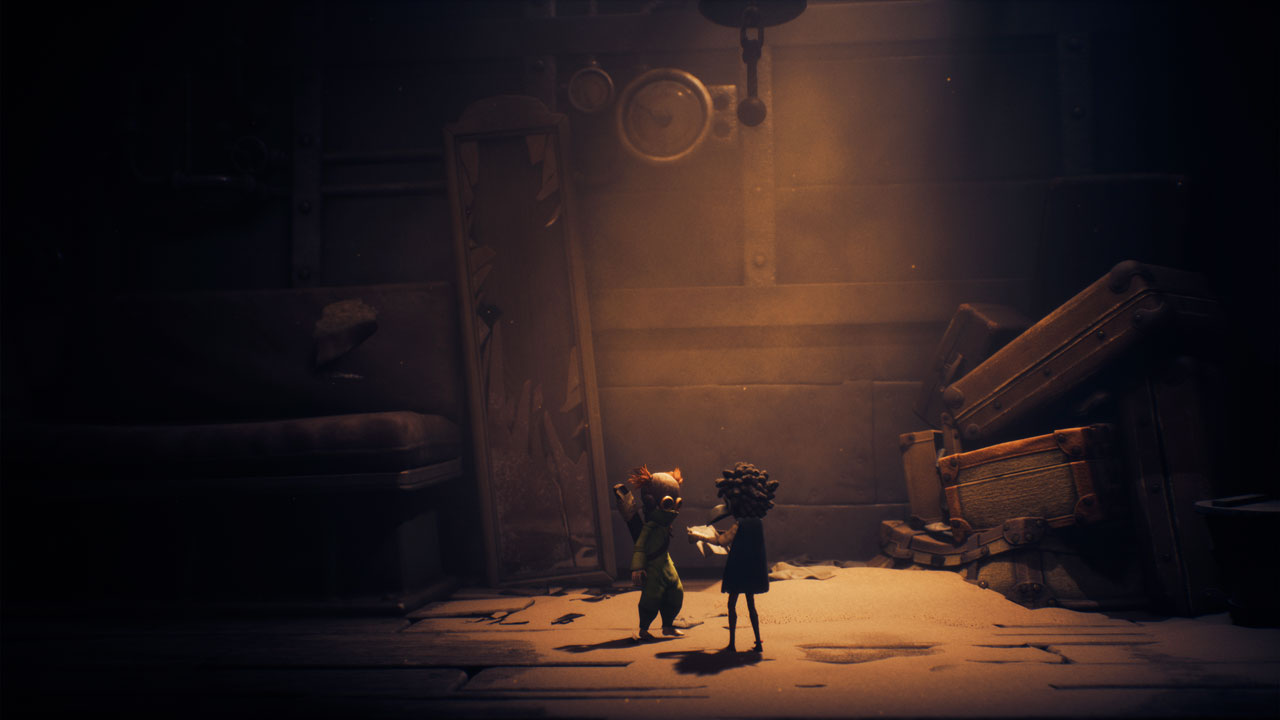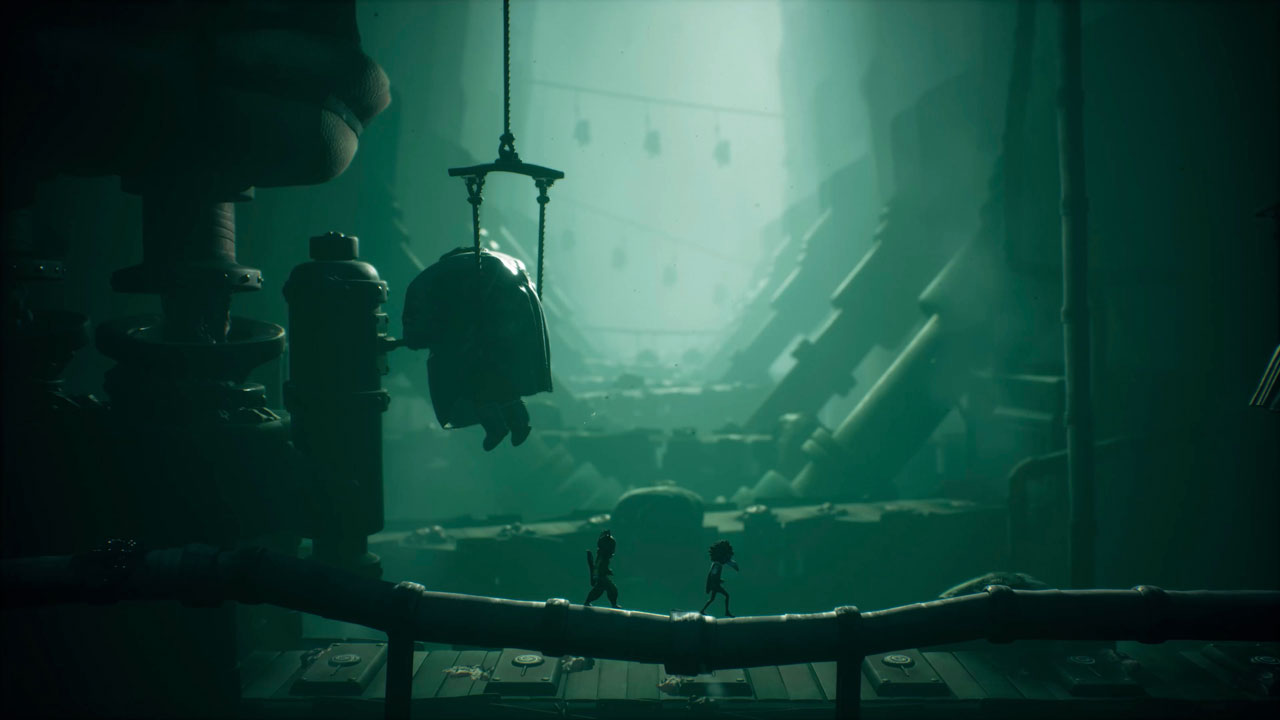From the moment you slip into the cracked shoes of Low and Alone, Little Nightmares 3 feels like a gentle push in a world built of tension. Supermassive has stepped into Tarsier’s shoes, and the first thing I noticed is how little they tried to reinvent the game. The core loop is what you expect: puzzles, hiding, creeping, occasionally running, culminating in a boss clash that reminds you just how fragile these children are in a hostile world, and I’m here for it.
Enter Low and Alone
The story begins quietly. Low, bow in hand, and Alone, with a wrench, awaken in The Nowhere, bound by circumstance. You don’t get exposition dumps. Instead, you feel the world pressing in. Each corridor, each shuttered door, each flicker of light suggests something wrong. This is horror told through absence and sound, not through splashes of blood. The game trusts you to read what’s between shadows.
You’ll do the familiar: solve puzzles, avoid monstrous foes, slip through tiny gaps, move boxes, pull levers. What changes is the interaction between the two protagonists. Low’s bow is used for ranged interactions like tipping off traps, pulling objects from a distance, and sometimes taking down smaller threats. Alone’s wrench on the other hand, is blunt and direct. She smashes, manipulates locks, and pushes machinery. The two often must act together, Low distracting while Alone climbs, or Alone holding something down while Low fetches the tool. That cooperative tension is the heart of Nightmares 3. The puzzles feel richer because you often have two distinct utilities to bring to bear. It’s not just “press this, then press that”; it’s more aligned and offers more sense of self. When it clicks, when you and Low or Alone (or your friend, or the AI) sync up, you get a moment of clarity, and that moment is why you play this game; it’s a feeling you want to achieve over and over again.
But because the game leans into darkness, literal darkness, I often found myself straining to see. In handheld mode on Switch 2, the black levels become literal black blobs unless your eyes are adjusted just so or unless your room is very dim. That tension works sometimes; it pushes you to slow down, but often it frustrates. I played in a dark room, hoping to preserve atmosphere, only to lose track of edges, miss crucial ledges, or not see the slight outline of something deadly. It’s a trade-off: you get a more oppressive mood at the cost of clarity. You can adjust the settings, and I wouldn’t recommend playing it with HDR-on, but if you’re playing it on a non-OLED screen, it’s something you’ll need to take into consideration for sure. I understand it’s an art style, and it does work to bring that eerie atmosphere, but sometimes it’s just a bit too dark. Things get better once you unlock some extra options in the game, so it’s definitely worth pushing through those initial dark levels.
Suppermassive
That being said, Supermassive sets a softer price, and you get around eight to nine hours of gameplay spread over a couple of levels we won’t spoil. Because of the scale of the game, there aren’t a lot of throwaway corridors. Each feels carefully designed, with verticality, secret nooks, multiple paths, shadowed alcoves, and more room to breathe than in the previous entries. You don’t feel railroaded, save for a few forced transitions. I appreciated that freedom and slight departure, thanks to Suppermassive.
Switching developers was always the risk. Would Supermassive understand the minimalist horror of Nightmares? They do, mostly. The art direction still holds: grotesque shapes, dilapidated machinery, stitched wood and metal, long limbs, exaggerated proportions. The grotesque is familiar but allow fresh input. The monsters are looser in design than before, more willing to stretch into caricature, and I liked that.
Atmospherically, it’s strong. The ambient hums, the near silence punctuated with creaks, the occasional musical swell they still terrify more than jump scares. There were many moments where I stopped just to listen, letting the world speak. That is still what Nightmares does best.
Invite an online friend
About co-op: this is the first Little Nightmares with online two-player co-op. If you own the game, a friend can join via a Friend’s Pass. If you go solo, AI steps in. That’s welcome, and in practice, the AI is serviceable; it doesn’t steal your spotlight, doesn’t solve every puzzle for you, but assists when you need it. I started my run with an AI, and besides a couple of glitches were the AI didn’t really understand what I wanted it to do it’s still a valid way to play the game. I would say playing with an AI increases the difficulty a little since you’re the only one solving the puzzles, really. Yet I missed couch co-op and the sense of holding your breath in the same room, waiting for your partner’s move, whispering directions. That physical bond feels diluted here. Also, the co-op is limited to the same platform only; you can’t pull in a friend on another console, something that will change in the future.
A familiar nightmare
The gameplay loop doesn’t drastically diverge from the first two entries, but that’s okay. Sometimes the best thing a sequel can do is refine rather than reinvent. The pacing is smoother. The leaps in complexity are gradual. When the game expects you to combine bow shots and wrench usage, by then you know both tools, and that feels rewarding rather than forced.
Boss fights are still highlight moments. You don’t fight directly often, but when you do, the puzzle is bigger: managing space, splitting roles, surviving one more whip or one more lunge. Some are memorization, yes, but memorable too. Because the game invests small things, you bring your fear into those fights.
Still, there are downsides. Some puzzles feel safe. In a few sections, I felt déjà vu: a corridor, a lever, a chase. It rarely derails, but it treads known territory. The game sometimes leans too hard into shadows to hide simplicity. And the aforementioned visibility problem can make it harsher than it needs to be.
But the characters hold it together. Low and Alone are more than interchangeable protagonists; they have different styles and different strategies. Their tools, their stances, the way they move, you sense their limitations. You feel when one is in danger, when one must risk, when one must wait. That dynamic, in this world, matters.
On Switch 2, I saw the game deliver what it needed to: frame rate held steady in most segments, transitions were crisp, textures held decent detail even in gloom. In handheld, it’s rougher, some textures blur, and shadows swallow detail. But not so much that the game becomes unplayable. Just a bit punishing in certain light conditions.
Conclusion:
In all, Little Nightmares 3 is a satisfying successor. It keeps the fragility, the terror, the childlike vantage point, and adds new bits to the puzzle. It doesn’t leap beyond its past, but it steps beside it. For fans, this is a welcome return. For new players, it’s a refined horror-puzzle ride that’s close enough to the familiar to welcome them in, but with room to carve its own shadow.




